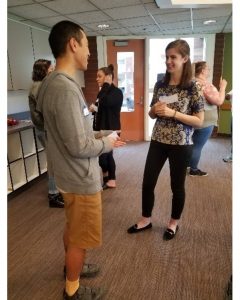by Anne Arias
“Your organization is Youth Development Executives of King County? So you represent the County government?”
“Well, no….”
Prompted in part by some of our colleagues’ experiences with potential stakeholders misinterpreting our organization’s name and the challenge of describing our work as an intermediary organization, earlier this year our team took on the challenge of developing and practicing our elevator pitch – what we would say given two minutes with a potential stakeholder (as if we were riding together briefly in an elevator).
name and the challenge of describing our work as an intermediary organization, earlier this year our team took on the challenge of developing and practicing our elevator pitch – what we would say given two minutes with a potential stakeholder (as if we were riding together briefly in an elevator).
Each of us thought first about our target audience—for example, for our Advocacy Manager it might be a legislator whereas for me it would likely be a leader from a youth-serving non-profit or a school district. What is that audience’s interest in our organization, and what is their potential influence over our work? This reflection enables me to think about what information I share or what story I can tell about our organization that strategically aligns with my audience’s interest and influence.

At our recent SEL Partnership Cohort session in November, participants completed an elevator pitch exercise for a target audience, using the following questions as a guide:
- What do you want this audience to know and do in relation to your program?
- How does your program support SEL and the whole child?
- Who does your program serve and why?
- What is the value of your program? How are you addressing inequities in the education system?
After drafting their first pitch, participants edited their speeches to fit into the “2-minute” elevator pitch timeline, reflecting on questions that included “Check for deficit language—do your words inadvertently reinforce the inequities or biases you are working to address?” and “Can you hear yourself saying this?”
After practicing their pitches with each other, one participant noted how surprising it is just how much meaning can be relayed about a program or partnership if we’re intentional about how we communicate. As we wrote about in our October blogpost, being thoughtful about what we say and who we say it to plays a significant role in building sustainable partnerships and programs. With that in mind, check out our introductory video which defines a youth development approach and describes how stakeholders can support the youth development field. And next time you see us – we look forward to hearing your pitch!


